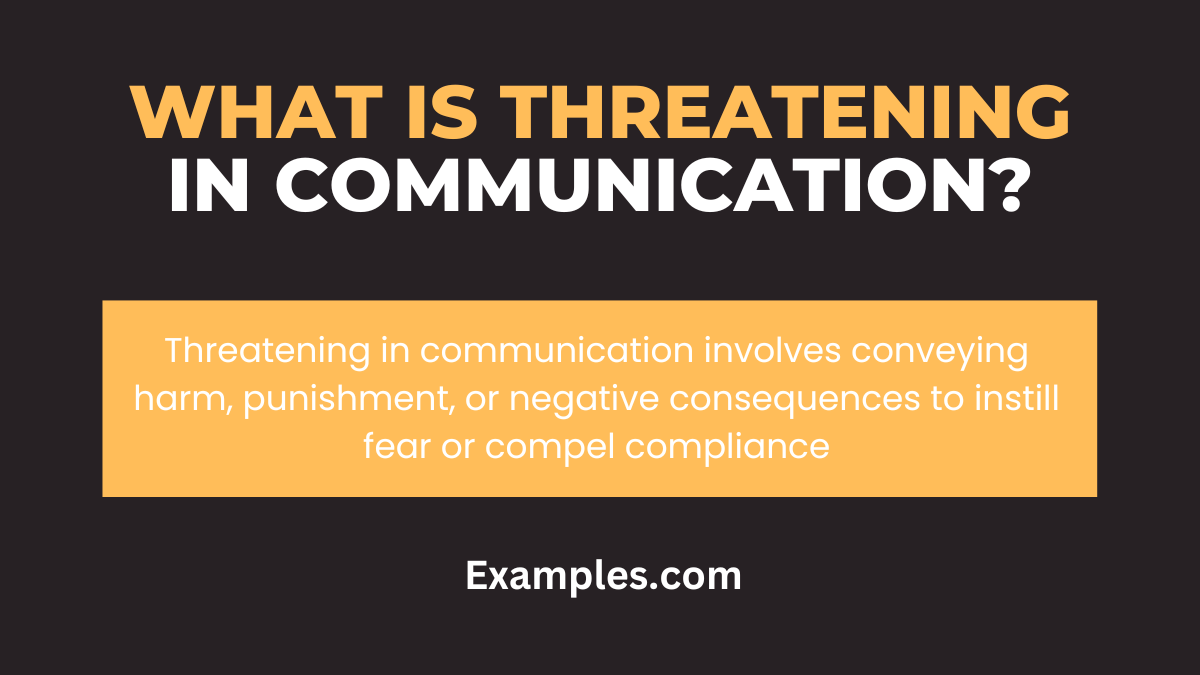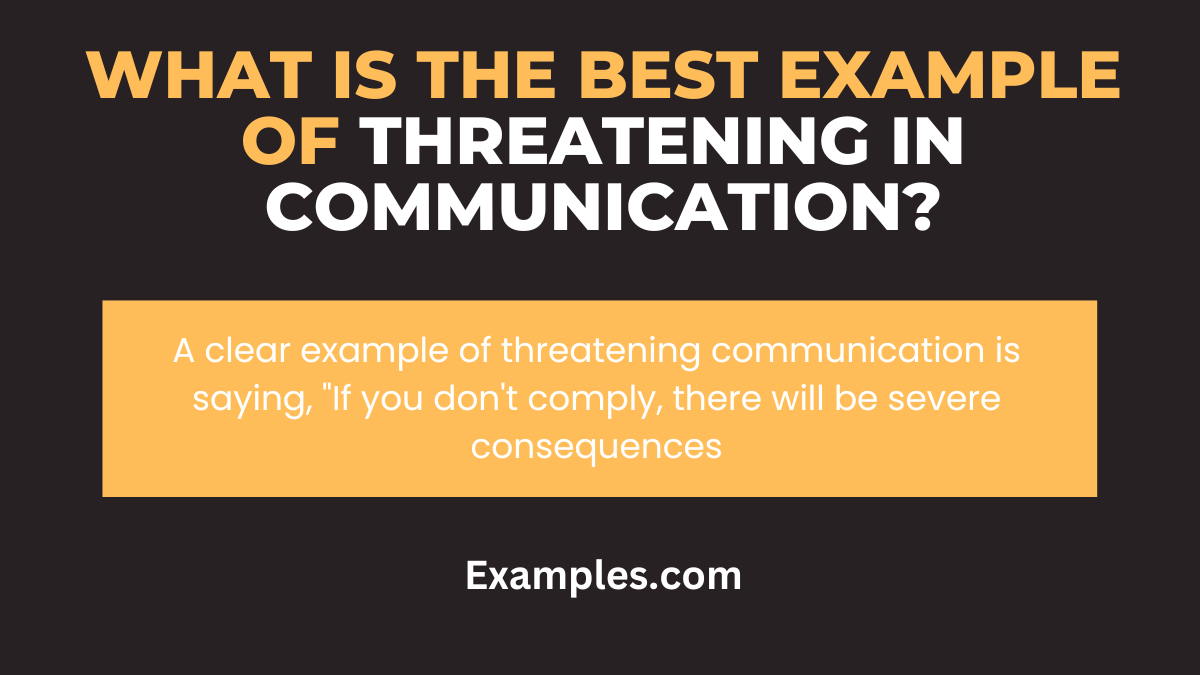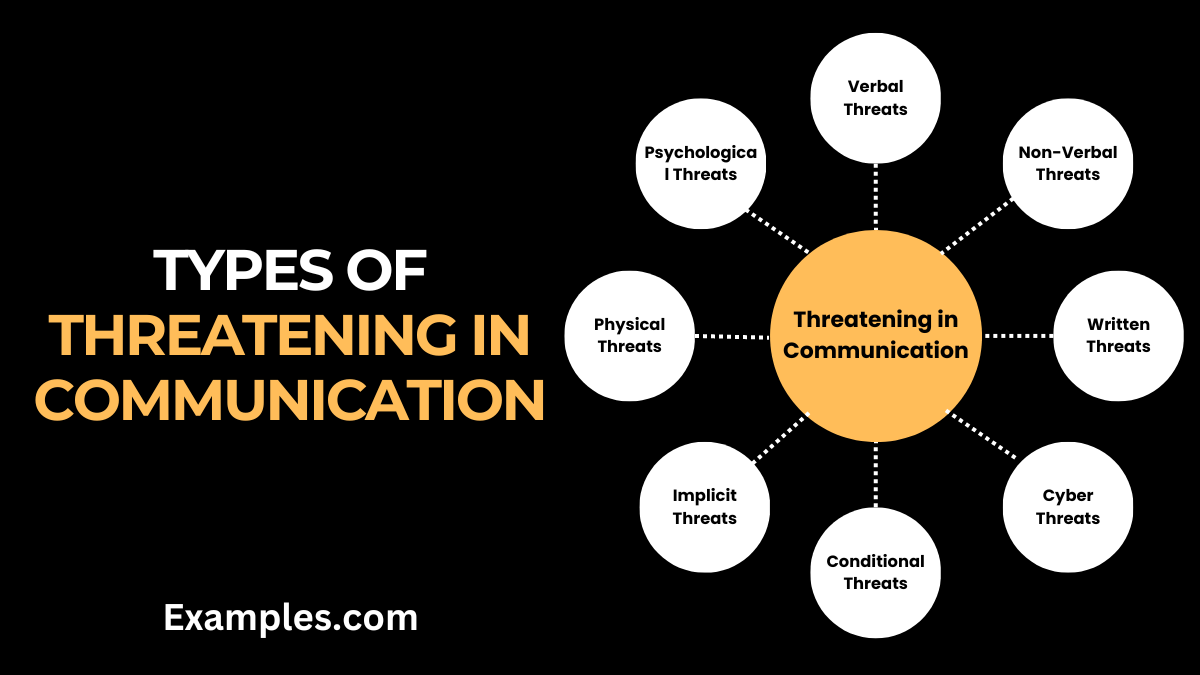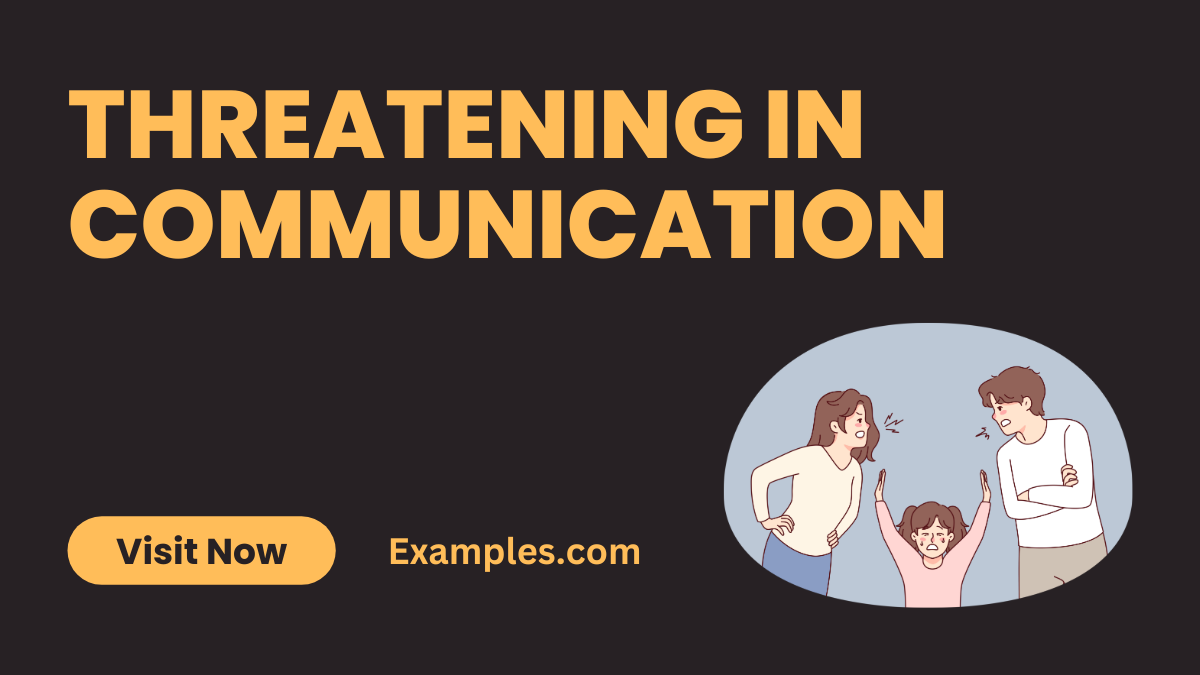19+ Threatening in Communication Examples
Threatening in Communication is a nuanced, yet critical aspect that shapes interpersonal dynamics. This comprehensive guide delves into the intricacies of threatening language, exploring its various forms and contexts. Understanding the nuances of Threatening in Communication is essential for anyone looking to navigate complex social interactions, whether in personal relationships or professional environments. From identifying subtle threats to learning de-escalation techniques, this guide offers a deep dive into the powerful impact of words and how they can be used or misused in communication.
What is Threatening in Communication?

Threatening in communication refers to expressions or gestures that imply harm or negative consequences. This can range from subtle insinuations to overt verbal threats, impacting the receiver’s sense of safety and well-being.
What is the Best Example of Threatening in Communication?

A classic example of threatening communication is a boss who uses aggressive language and tone to demand immediate results from their team, implying negative consequences for failure. This creates an atmosphere of fear and stress, impacting the team’s morale and productivity.
20 Examples of Threatening in Communication
Threatening communication, a form of Aggressive Communication, is a detrimental interaction style that involves intimidation, coercion, or instilling fear in others. This harmful communication tactic can manifest in various contexts, from personal relationships to workplace interactions. Understanding the nature of threatening communication is crucial to recognize and address it effectively. The following examples, each with a brief explanation and sample sentences, illustrate different forms of threatening communication.
- Direct Threats in Arguments: Explicitly stating harm to coerce someone. “If you don’t agree, you’ll regret it.”
- Veiled Threats in Negotiations: Implied threats hidden in seemingly normal conversation. “It would be a shame if something happened to your project.”
- Blackmail in Relationship Conflicts: Using sensitive information as leverage. “Do as I say, or I’ll reveal your secret.”
- Intimidating Body Language in Discussions: Using physical presence to threaten. “Steps closer aggressively – “Are you sure you want to say that?”*
- Hostile Ultimatums in Team Meetings: Forcing a decision under threat of negative consequences. “Agree with this, or you’re off the team.”
- Aggressive Tone in Verbal Communication: Conveying threats through a menacing tone. “Speaks menacingly – “You better reconsider your decision.”*
- Threatening Job Security in Workplace: Imposing fear of job loss to ensure compliance. “Follow my orders, or you’ll be searching for a new job.”
- Emotional Blackmail in Personal Relationships: Manipulating someone by threatening emotional distress. “If you leave, I’ll be devastated.”
- Using Authority to Intimidate in Professional Settings: Exploiting power imbalance to threaten. “As your boss, I can make your life difficult here.”
- Threatening Legal Action in Disputes: Using the threat of legal repercussions to gain an advantage. “If you don’t comply, I’ll see you in court.”
- Passive-Aggressive Threats in Communication: Subtly threatening through indirect communication. “It would be unfortunate if I forgot to do this favor for you.”
- Threatening Reputation in Social Settings: Warning of damaging someone’s social standing. “If you cross me, I’ll ruin your reputation.”
- Cyber Threats in Digital Communication: Using online platforms to threaten harm. “Sends threatening messages online – “Watch your back.”*
- Threatening Financial Security: Imposing fear of financial loss. “Do this, or I cut off your funding.”
- Coercion in Persuasive Communication: Forcing agreement through threats. “You have no choice but to agree with me.”
- Threatening Withdrawal of Affection: Using the threat of emotional detachment as leverage. “If you don’t do this, I won’t speak to you again.”
- Intimidation in Public Speaking: Using threatening language to dominate a conversation. “Anyone who disagrees with me will face consequences.”
- Threatening Physical Harm in Altercations: Directly or indirectly suggesting physical violence. “Keep pushing, and see what happens.”
- Threatening to Withhold Resources: Using control over resources as a threat. “Do what I say, or I’ll cut off your access.”
- Manipulative Threats in Power Dynamics: Leveraging power imbalances to threaten. “Remember, I have the power to decide your fate here.”
How to Respond to a Threatening in Communication?
- Stay Calm: Maintain composure to think clearly and respond rationally.
- Listen Actively: Understand the content and context of the threat.

- Assess Safety: Prioritize personal safety in potentially harmful situations.
- Avoid Escalation: Refrain from responding with aggression or hostility.
- Seek Clarification: Ask for specifics to understand the threat better.
- Document the Threat: Keep a record of the threatening communication.
- Use Assertive Communication: Respond firmly but respectfully.
- Seek Support: Consult with superiors, legal counsel, or authorities when necessary.
Types of Threatening in Communication

- Verbal Threats: Direct or indirect statements of intent to cause harm.
- Non-Verbal Threats: Intimidating gestures or expressions.
- Written Threats: Threatening messages via emails, letters, or texts.
- Cyber Threats: Online harassment or cyberbullying.
- Conditional Threats: Statements implying harm based on certain conditions.
- Implicit Threats: Vague or insinuated threats without explicit harm.
- Physical Threats: Gestures implying physical harm.
- Psychological Threats: Statements intended to instill fear or distress.
What to Do if You Receive Threatening Communication?
- Do Not Respond Impulsively: Avoid immediate confrontation or retaliation.
- Ensure Personal Safety: Remove yourself from potentially dangerous situations.
- Document the Communication: Keep a record of all forms of threatening communication.
- Inform Relevant Authorities: Report the threat to law enforcement if necessary.
- Seek Legal Advice: Consult a lawyer to understand your rights and options.
- Inform Your Workplace or Institution: If relevant, inform your workplace or educational institution.
- Use Support Networks: Reach out to family, friends, or support groups.

- Consider Professional Help: Seek counseling or psychological support if needed.
Recognizing the impact of threatening communication is crucial. This article has offered valuable insights and practical tips on avoiding such behavior while effectively conveying your message. By fostering respectful and constructive communication, you can build healthier relationships and resolve conflicts without resorting to threats. Emphasizing empathy and understanding is key to promoting positive interactions in all aspects of life.



